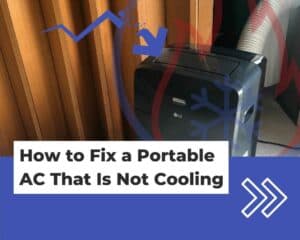Portable Air Conditioners are becoming increasingly popular for their ability to cool indoor spaces without the need for permanent installation – especially since you can just go buy one and have it running the same day.
But have you ever wondered how a portable air conditioner keeps your room cool and comfortable during those hot summer days?
In this article, I’ll dive deep into the inner workings of portable air conditioners, exploring their components and processes, and focusing on how they cool the air in your home.
I’ll also explain the specific sequence that occurs when a portable AC turns on, and go over some of the safety and alarm devices that monitor the status of your portable air conditioner!
How a Portable Air Conditioner Cools the Air
A portable air conditioner cools the air by absorbing heat from indoor air through an evaporator coil, while a fan distributes the cooled air. The absorbed heat is then expelled outdoors via a condenser coil and an exhaust fan.
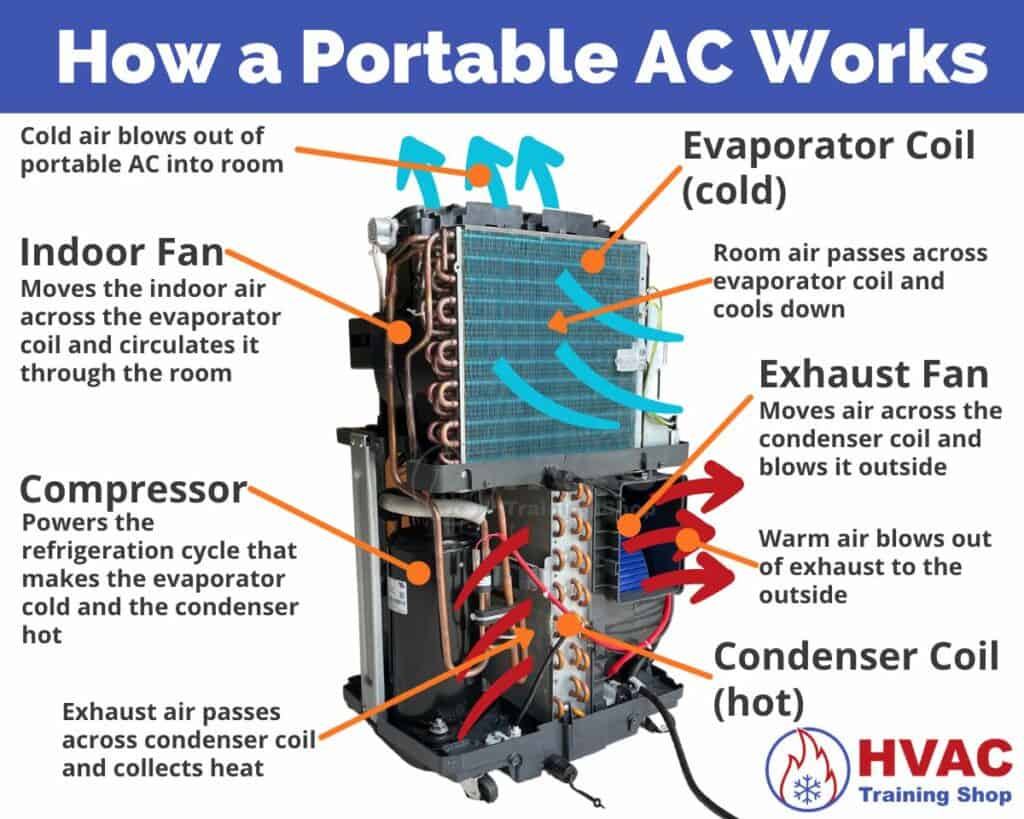
Below, I’ll get into the technical specifics of what happens when a portable air conditioner runs, and then explain all of the portable air conditioner’s components in detail.
The Sequence of Operation for a Portable Air Conditioner
So you just turned on your portable AC and turned down its temperature setpoint to cool your room. What happens next?
Here’s a step-by-step technical explanation of the sequence of operation for a portable air conditioner:
- The thermostat detects that the room temperature is above the set point and sends a signal to the portable air conditioner’s control board to initiate cooling.
- The control board starts the indoor fan, drawing warm indoor air across the evaporator coil to initiate the heat transfer process.
- The control board starts the exhaust fan simultaneously, ensuring the constant flow of outdoor air across the condenser coil for efficient heat rejection.
- The control board activates the compressor, pressurizing the refrigerant and circulating it between the evaporator and condenser coils.
- The refrigerant in the evaporator coil absorbs heat from the indoor air, cooling it and blowing it back into the room.
- The hot refrigerant gas is circulated through the condenser coil, releasing the absorbed heat into the exhaust air.
- This cycle repeats until the thermostat detects that the room temperature has reached the desired set point, at which point the control board shuts off the compressor, followed by the indoor and exhaust fans.
The Components of a Portable Air Conditioner
To better understand how a portable air conditioner works, we need to explore the key components in detail:
Evaporator Coil
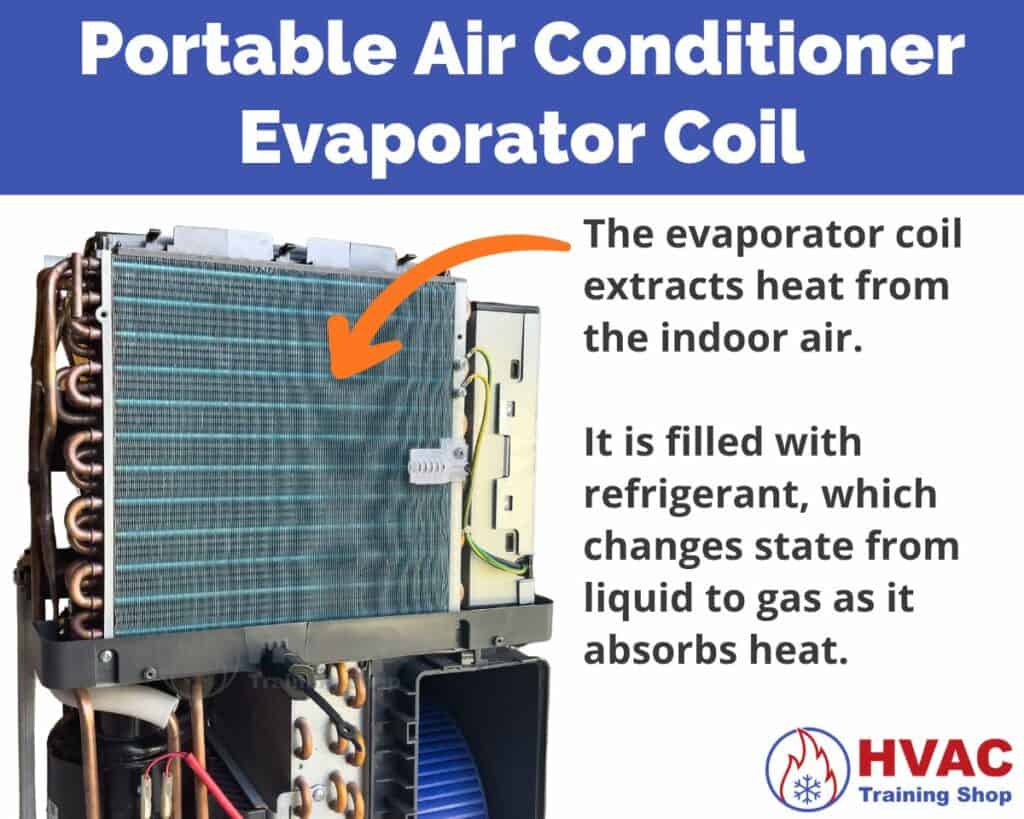
- A heat exchanger that absorbs heat from the indoor air
- Typically made of copper and aluminum, as these materials have excellent heat transfer properties
- Filled with a refrigerant, which changes state from liquid to gas as it absorbs heat
The evaporator coil’s primary function is to extract heat from the indoor air. As the warm air passes across the coil, the refrigerant inside evaporates, changing state from liquid phase to gas phase. The phase change process absorbs heat, thus cooling the air.
Indoor Fan
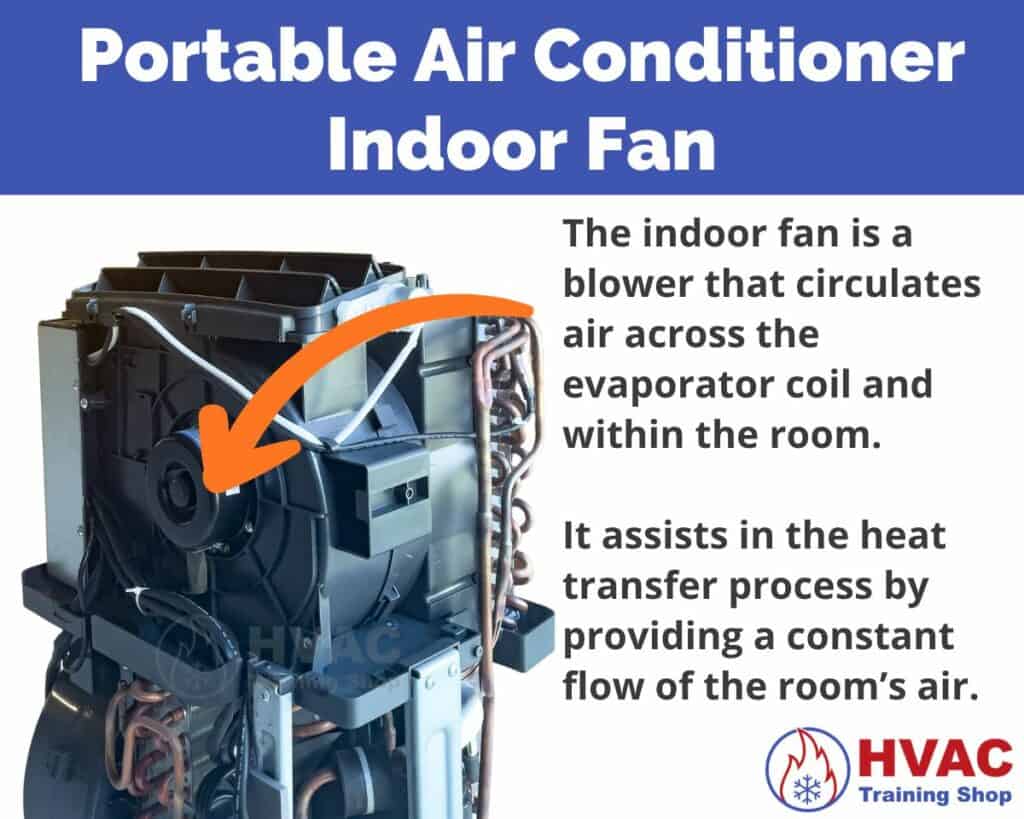
- A blower that circulates air across the evaporator coil and within the room
- Helps distribute cooled air throughout the room
- Assists in the heat transfer process by providing a constant flow of the room’s air
The indoor fan plays an essential role in the overall cooling process by moving the indoor air across the evaporator coil. This airflow aids in efficient heat exchange by moving heat from the indoor air into the evaporator.
Condenser Coil

- A heat exchanger that releases heat from the refrigerant to the outdoor air
- Like the evaporator coil, it is made of copper and aluminum for efficient heat transfer
- Filled with a refrigerant, which changes state from gas to liquid as it releases heat
The condenser coil is responsible for transferring the heat absorbed by the refrigerant to the outdoor air. As the hot refrigerant gas passes through the coil, it condenses back into a liquid state, releasing the heat in the process.
Exhaust Fan

- A blower responsible for expelling hot air from the condenser coil to the outside
- Helps move heat from the room to the outside
- Assists in the heat transfer process by ensuring a constant flow of hot air to the outside
The exhaust fan is another critical component in the portable air conditioner’s operation. Its main function is to expel the hot air generated during the heat rejection process from the condenser coil to the outdoors.
By providing a constant flow of air, the exhaust fan contributes to maintaining the efficiency of the heat rejection process by moving heat from the condenser coil to the outside.
Most portable ACs have an exhaust hose that attaches to the outlet of the exhaust fan. The exhaust hose provides a conduit for the hot air blown by the exhaust fan. By channeling the hot air outside, the exhaust hose ensures the efficiency of the cooling process and prevents the heat from being recirculated back into the room.
Compressor

- A pump that compresses the refrigerant gas and moves it between the evaporator and condenser coils
- Powered by an electric motor
- The compression of the refrigerant vapor increases its ability to release heat
The compressor is the main driving force in the refrigeration cycle. The compressor creates a pressure differential in the refrigerant system of the portable AC. This pressure differential drives the refrigerant flow through the other components in the air conditioning’s refrigerant system.
The compressor increases the pressure and temperature of the refrigerant gas, enhancing the refrigerant’s ability to absorb heat in the evaporator coil and release it in the condenser coil.
Speaking of the refrigerant, now’s a good time to go over that. I’ll explain how the refrigeration cycle in a portable air conditioner works below.
The Refrigeration Cycle in a Portable Air Conditioner
Portable air conditioners work on the principle of the vapor-compression refrigeration cycle. This process involves the circulation of a refrigerant through a closed-loop system, absorbing heat from the indoor air and releasing it to the outdoor air.
With a comprehensive understanding of the components, let’s now examine the refrigeration cycle that occurs within a portable air conditioner:
- The indoor fan draws warm indoor air across the evaporator coil, initiating the heat transfer process.
- The refrigerant within the evaporator coil absorbs the heat from the air, evaporating and changing state from liquid to gas.
- The now-cooled air is blown back into the room by the fan, providing cool air to the indoor environment.
- The compressor pressurizes the gaseous refrigerant, increasing its temperature and pressure.
- The hot refrigerant gas is circulated through the condenser coil, where it releases the absorbed heat into the outdoor air by the exhaust fan.
- The refrigerant, now cooled and in a liquid state, flows back to the evaporator coil through an expansion valve, which reduces its pressure and temperature, and the cycle repeats.
Alarm, Safety, and Additional Components in Portable Air Conditioners
Portable air conditioners incorporate several safety mechanisms and alarms to ensure proper operation and protect the unit from potential damage.
There are also a few other components that portable air conditioners need to run, other than the ones I already mentioned above.
Let’s explore some of those components in detail.
Float Switch

- A safety device designed to prevent water overflow from the condensate collection tray
- Activates when the water level in the tray reaches a certain point
- Shuts off the unit to avoid water damage and potential electrical hazards
The float switch is a safety feature that detects the water level in the portable AC’s condensate collection tray.
When the water reaches a predetermined level, the float switch activates, shutting down the unit to prevent overflow and potential damage to the unit or surrounding environment.
Evaporator Coil Temperature Sensor
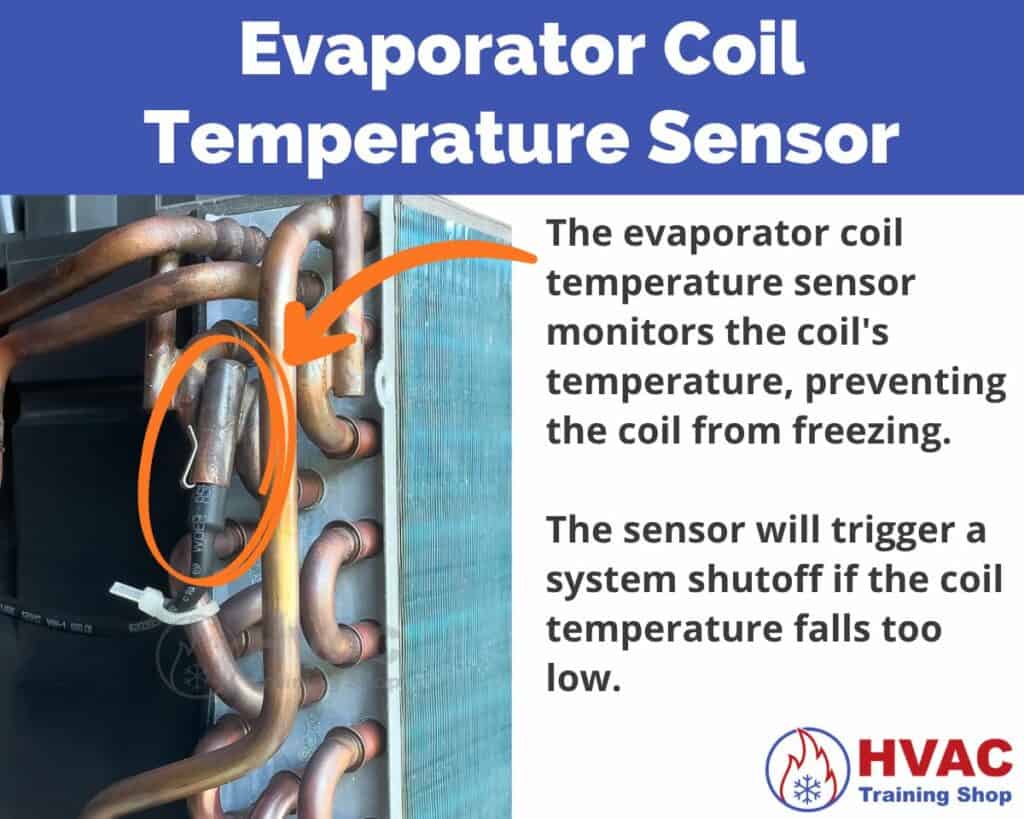
- Monitors the temperature of the evaporator coil
- Can trigger a safety shut-off if the evaporator coil temperature falls below a specified value
The evaporator coil temperature sensor constantly monitors the coil’s temperature, preventing the coil from freezing.
If the sensor detects a temperature below a specified value, it can trigger a safety shut-off to protect the unit from potential damage.
High-Pressure Switch
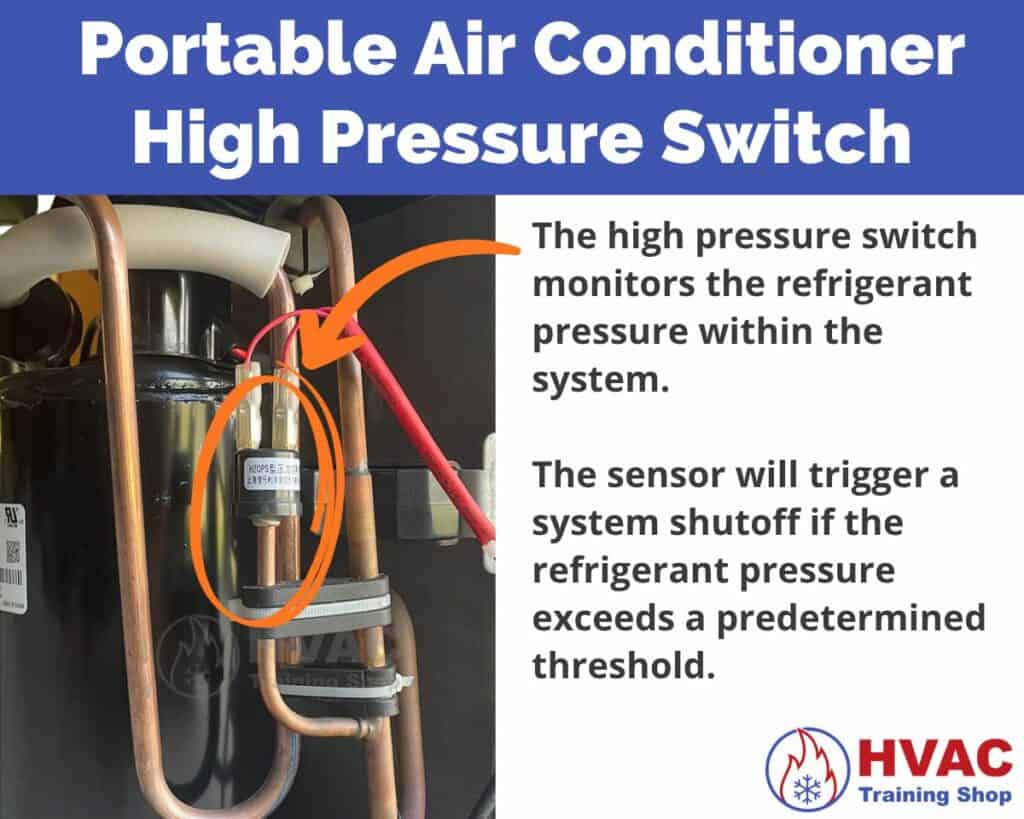
- A safety device that monitors the refrigerant pressure within the system
- Prevents damage to the compressor due to excessive pressure
- Shuts off the unit if the refrigerant pressure exceeds a predetermined threshold
The high-pressure switch is a critical safety component that monitors the refrigerant pressure within the portable air conditioner.
If the refrigerant pressure exceeds a specified threshold, the high-pressure switch shuts off the unit to prevent damage to the compressor and other components.
Condensate Slinger, Splasher, or Sprayer

- A device that helps to evaporate collected condensation
- Reduces the need for manual drainage of the condensate collection tray
- Enhances the overall efficiency of the portable air conditioner
The condensate slinger or splasher is a component designed to automatically evaporate collected condensation, thus reducing the need for manual drainage.
By splashing the collected condensate onto the hot condenser coil, the water evaporates and gets blown outside through the exhaust hose, effectively “self-draining” the portable air conditioner.
The condensate slinger also contributes to the efficiency of the portable air conditioner by cooling off and removing heat from the condenser coil.
Most portable ACs on the market nowadays are self-evaporating, so they include the condensate slinger component. However, most older non-self-evaporating portable AC units don’t have this component so they must be drained manually, or by using a continuous drain hose.
Fan and Compressor Capacitors
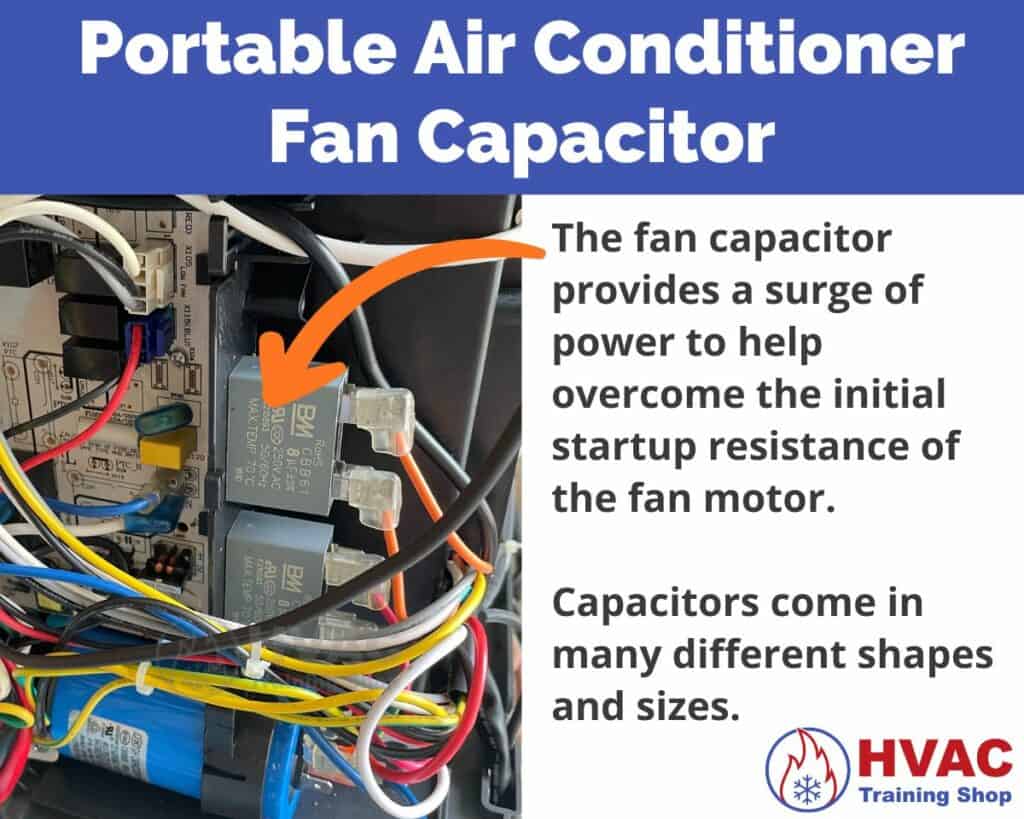
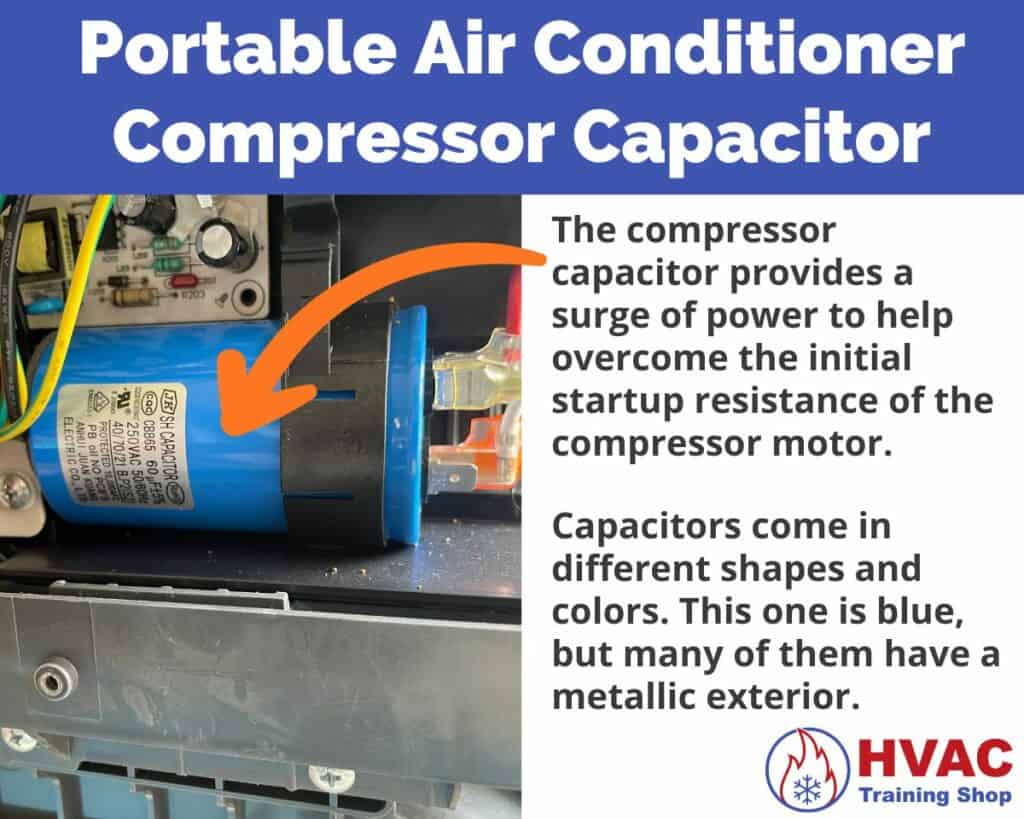
- Electrical components that store and release energy
- Necessary for the proper starting and operation of the portable AC’s fans and compressor
- Provide a surge of power to help overcome the initial resistance of the fan and compressor motors
Fan and compressor capacitors are crucial electrical components that store and release energy, enabling the proper starting and operation of the unit’s fans and compressor.
By providing a surge of power, the capacitors help overcome the initial resistance of these motors, allowing the fans and compressor to start easily.



